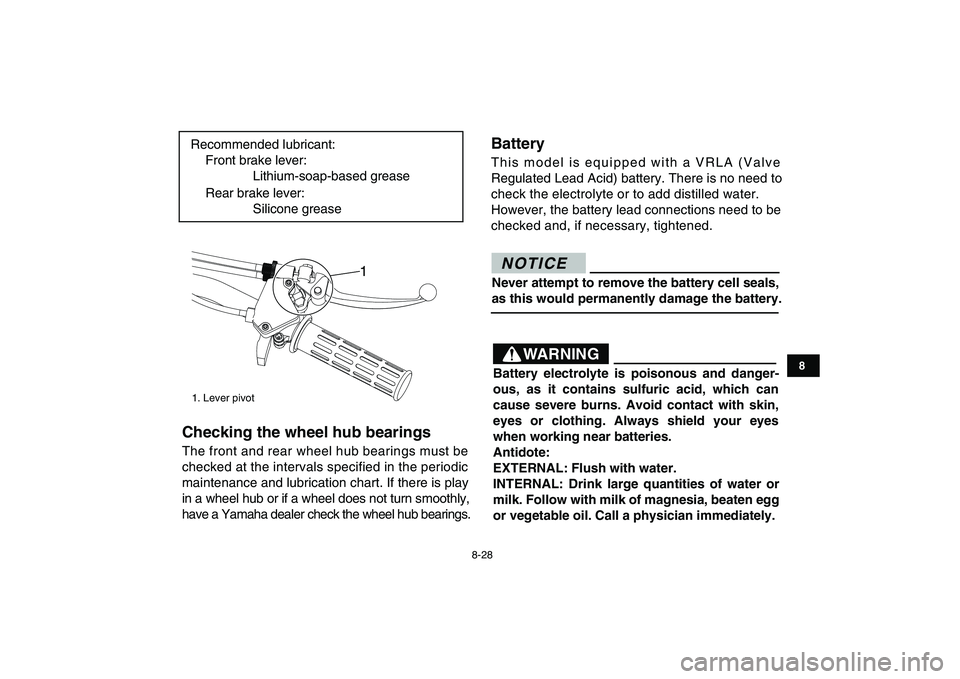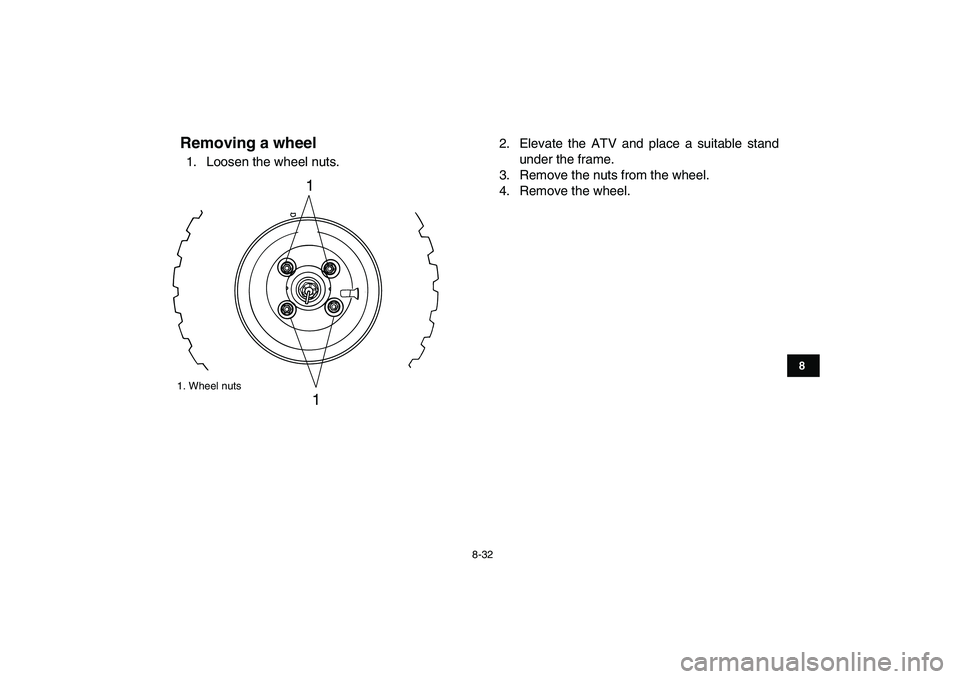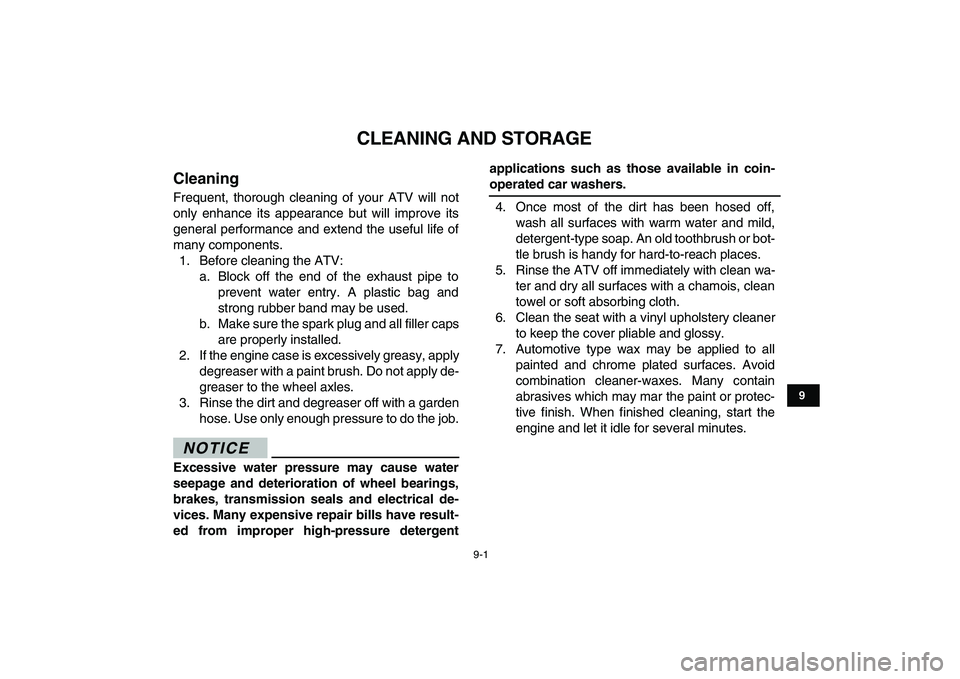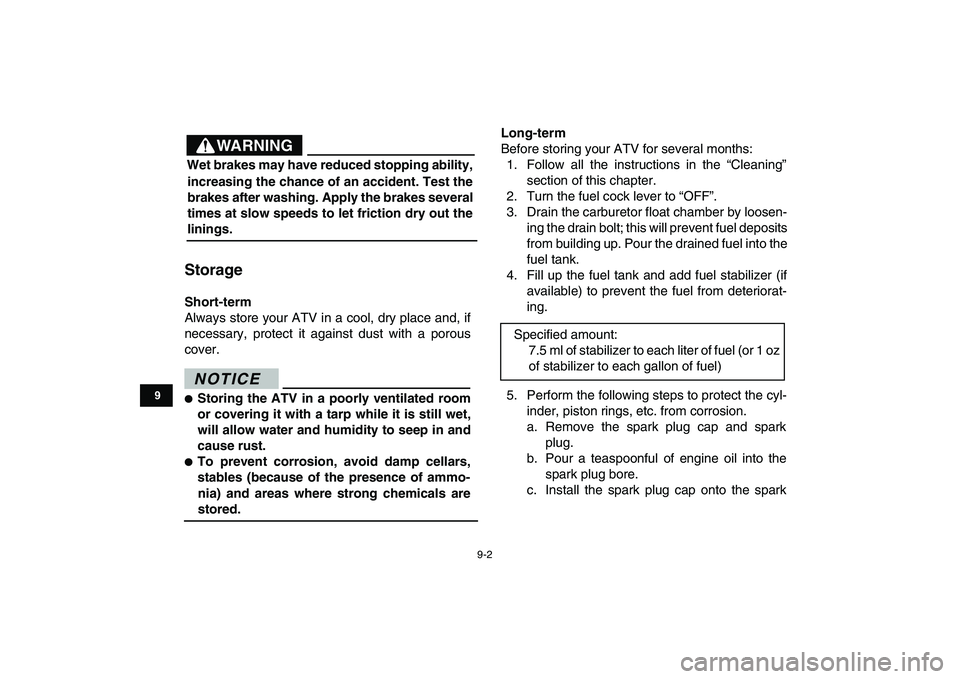YAMAHA YFM90R 2009 Owners Manual
Manufacturer: YAMAHA, Model Year: 2009, Model line: YFM90R, Model: YAMAHA YFM90R 2009Pages: 120, PDF Size: 9.14 MB
Page 101 of 120

8-28
8
Checking the wheel hub bearings The front and rear wheel hub bearings must be
checked at the intervals specified in the periodic
maintenance and lubrication chart. If there is play
in a wheel hub or if a wheel does not turn smoothly,
have a Yamaha dealer check the wheel hub bearings.1. Lever pivot
BatteryT h i s m o d e l i s e q u i p p e d w i t h a V R L A ( V a l v e
Regulated Lead Acid) battery. There is no need to
check the electrolyte or to add distilled water.
However, the battery lead connections need to be
checked and, if necessary, tightened.
Recommended lubricant:Front brake lever: Lithium-soap-based grease
N O T I C E Never attempt to remove the battery cell seals,
as this would permanently damage the battery.
1
WARNING
Battery electrolyte is poisonous and danger-
ous, as it contains sulfuric acid, which can
cause severe burns. Avoid contact with skin,
eyes or clothing. Always shield your eyes
when working near batteries.
Antidote:
EXTERNAL: Flush with water.
INTERNAL: Drink large quantities of water or
milk. Follow with milk of magnesia, beaten egg
or vegetable oil. Call a physician immediately.
Rear brake lever:
Silicone grease
Page 102 of 120

8-29
To charge the battery
Have a Yamaha dealer charge the battery as soon
as possible if it seems to have discharged. Keep in
mind that the battery tends to discharge more quicklyif the ATV is equipped with optional electrical
accessories. To store the battery
1. If the ATV will not be used for more than one
month, remove the battery, fully charge it, and
then place it in a cool, dry place.
2. If the battery will be stored for more than two months, check it at least once a month and fully
charge it if necessary.
To install the battery
TIPBe sure the battery is fully charged. 1. Place the battery in its compartment.
2. Make sure to properly connect the battery leads to the battery terminals.
8
1. Battery
2. Negative lead
3. Positive lead
12
3
EYES: Flush with water for 15 minutes and get
prompt medical attention.
Batteries produce explosive gases. Keep
sparks, flame, cigarettes or other sources of ig-
nition away. Ventilate when charging or using
in an enclosed space.KEEP OUT OF REACH OF CHILDREN.
Page 103 of 120

8-30
1. Turn the key to “OFF” and turn off all electricalcircuits.N O T I C E To prevent accidental short-circuiting, turn off
the main switch when checking or replacing afuse.
2. Remove the blown fuse, and then install a new fuse of the specified amperage.
Specified fuse: 10 A
The fuse holder is located under the seat.
8
(See page 4-9.)
If the fuse is blown, replace it as follows.
1. Fuse
2. Spare fuseN O T I C EAlways keep the battery charged. Storing a
discharged battery can cause permanent
battery damage.To charge a VRLA (Valve Regulated Lead Acid)
battery, a special (constant-voltage) battery
charger is required. Using a conventional
battery charger will damage the battery. If you
do not have access to a constant-voltage
battery charger, have a Yamaha dealer charge
your battery.
1
2
Replacing the fuse
WARNING
Always use a fuse of the specified rating, and
never use a substitute object in place of the
proper fuse. An improper fuse or a substitute
object can cause damage to the electrical sys-tem, which could lead to a fire.
Page 104 of 120

8-31
3. Turn the key to “ON” and turn on the electricalcircuits to check if the devices operate.
4. If the fuse immediately blows again, have a Yamaha dealer check the electrical system.
8
Page 105 of 120

8-32
2. Elevate the ATV and place a suitable standunder the frame.
3. Remove the nuts from the wheel.
4. Remove the wheel.
1. Wheel nutsRemoving a wheel 1. Loosen the wheel nuts.
8
1
1
Page 106 of 120

8-33
2. Lower the ATV to the ground.
3. Tighten the wheel nuts to the specifiedtorques.
Tightening torques: Front wheel nut:45 Nm (4.5 m·kgf, 33 ft·lbf)
Rear wheel nut: 45 Nm (4.5 m·kgf, 33 ft·lbf)
wheel.
Front
1. Arrow markInstalling a wheel 1. Install the wheel and the nuts.TIPWhen installing the wheel, make sure its arrow
mark points toward the rotating direction of the
8
1
Page 107 of 120

8-34
TroubleshootingAlthough Yamaha ATVs receive a thorough in-
spection before shipment from the factory, trouble
may occur during operation. Any problem in the fu-
el, compression, or ignition systems, for example,
can cause poor starting and loss of power.
The following troubleshooting chart represents a
quick and easy procedure for checking these vital
systems yourself. However, should your ATV re-
quire any repair, take it to a Yamaha dealer, whose
skilled technicians have the necessary tools, expe-
rience, and know-how to service the ATV properly.
Use only genuine Yamaha replacement parts. Im-
itation parts may look like Yamaha parts, but they
are often inferior, have a shorter service life and
can lead to expensive repair bills.
8
WARNING
Do not smoke when checking the fuel system.
Fuel can ignite or explode, causing severe inju-
ry or property damage. Make sure there are no
open flames or sparks in the area, including pi-lot lights from water heaters or furnaces.
Page 108 of 120

8-35
Troubleshooting chart
Check the fuel level in
the fuel tank.1. Fuel
There is enough fuel.There is no fuel.
Check the compression.
Supply fuel.
The engine does not start.
Check the compression.
Operate the electric starter.2. Compression
There is compression.
There is no compression.
Check the ignition. Have a Yamaha dealer
check the ATV.
Remove the spark plug
and check the electrodes.3. Ignition
Wipe off with a dry cloth and correct the
spark plug gap, or replace the spark plug.
Have a Yamaha dealer check the ATV.
The engine does not start.
Have a Yamaha dealer
check the ATV.
The engine does not start.
Check the battery.
Operate the electric starter.4. Battery
The engine turns over
quickly.
The engine turns over
slowly.
The battery is good.Check the battery lead connections, and
charge the battery if necessary.
DryWet
Open the throttle halfway and operate
the electric starter.
8
Page 109 of 120

9-1
CLEANING AND STORAGE
CleaningFrequent, thorough cleaning of your ATV will not
only enhance its appearance but will improve its
general performance and extend the useful life of
many components.1. Before cleaning the ATV: a. Block off the end of the exhaust pipe toprevent water entry. A plastic bag and
strong rubber band may be used.
b. Make sure the spark plug and all filler caps are properly installed.
2. If the engine case is excessively greasy, apply degreaser with a paint brush. Do not apply de-
greaser to the wheel axles.
3. Rinse the dirt and degreaser off with a garden hose. Use only enough pressure to do the job.N O T I C EExcessive water pressure may cause water
seepage and deterioration of wheel bearings,
brakes, transmission seals and electrical de-
vices. Many expensive repair bills have result-
ed from improper high-pressure detergent applications such as those available in coin-
operated car washers.
4. Once most of the dirt has been hosed off, wash all surfaces with warm water and mild,
detergent-type soap. An old toothbrush or bot-
tle brush is handy for hard-to-reach places.
5. Rinse the ATV off immediately with clean wa- ter and dry all surfaces with a chamois, clean
towel or soft absorbing cloth.
6. Clean the seat with a vinyl upholstery cleaner to keep the cover pliable and glossy.
7. Automotive type wax may be applied to all painted and chrome plated surfaces. Avoid
combination cleaner-waxes. Many contain
abrasives which may mar the paint or protec-
tive finish. When finished cleaning, start the
engine and let it idle for several minutes.
9
Page 110 of 120

9-2
StorageShort-term
Always store your ATV in a cool, dry place and, if
necessary, protect it against dust with a porous
cover.N O T I C EStoring the ATV in a poorly ventilated room
or covering it with a tarp while it is still wet,
will allow water and humidity to seep in and
cause rust.To prevent corrosion, avoid damp cellars,
stables (because of the presence of ammo-nia) and areas where strong chemicals arestored. Long-term
Before storing your ATV for several months:
1. Follow all the instructions in the “Cleaning” section of this chapter.
2. Turn the fuel cock lever to “OFF”.
3. Drain the carburetor float chamber by loosen- ing the drain bolt; this will prevent fuel deposits
from building up. Pour the drained fuel into the
fuel tank.
4. Fill up the fuel tank and add fuel stabilizer (if available) to prevent the fuel from deteriorat-
ing.
5. Perform the following steps to protect the cyl- inder, piston rings, etc. from corrosion.
a. Remove the spark plug cap and sparkplug.
b. Pour a teaspoonful of engine oil into the spark plug bore.
c. Install the spark plug cap onto the spark
Specified amount:
7.5 ml of stabilizer to each liter of fuel (or 1 oz
of stabilizer to each gallon of fuel)
9
WARNING
Wet brakes may have reduced stopping ability,
increasing the chance of an accident. Test the
brakes after washing. Apply the brakes several
times at slow speeds to let friction dry out thelinings.